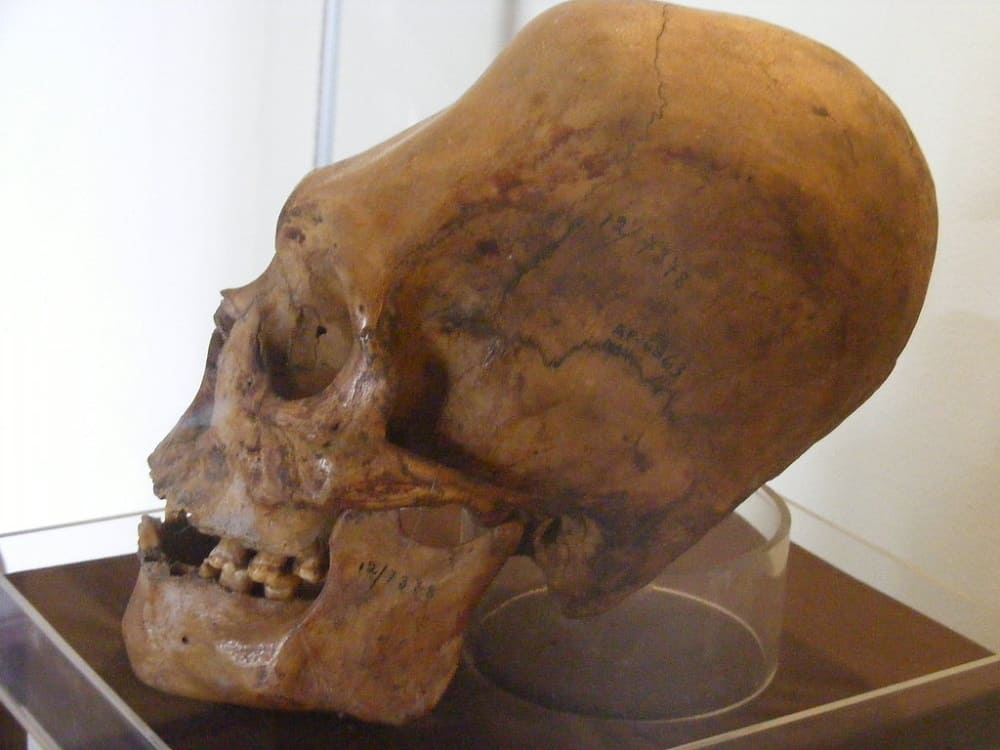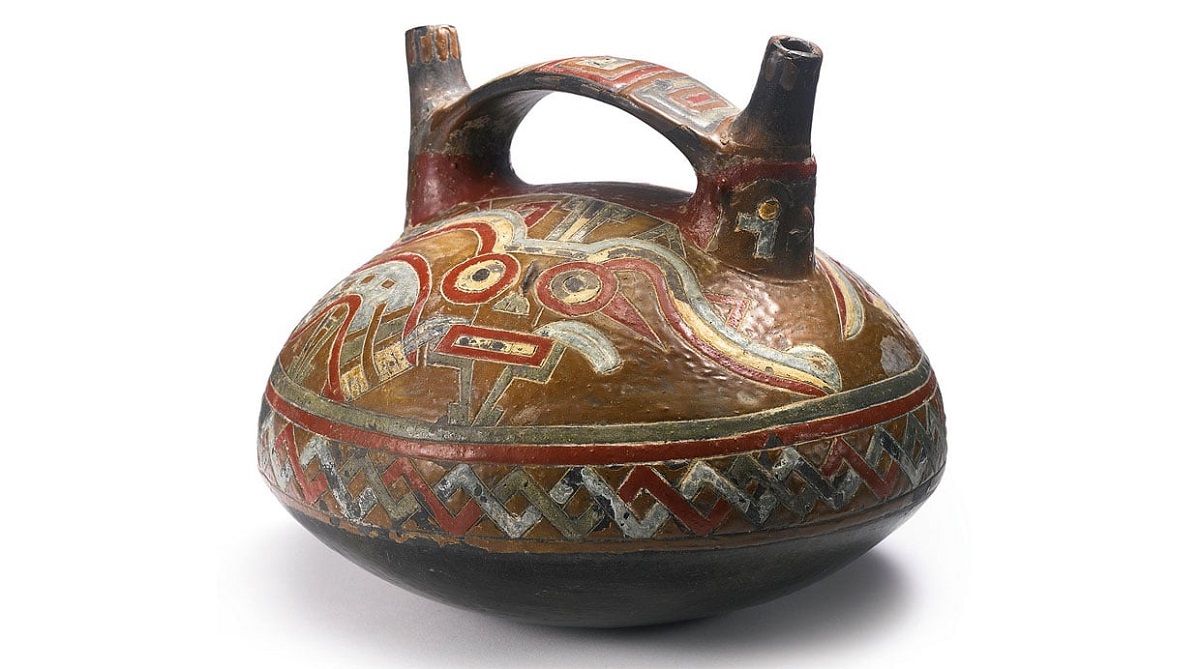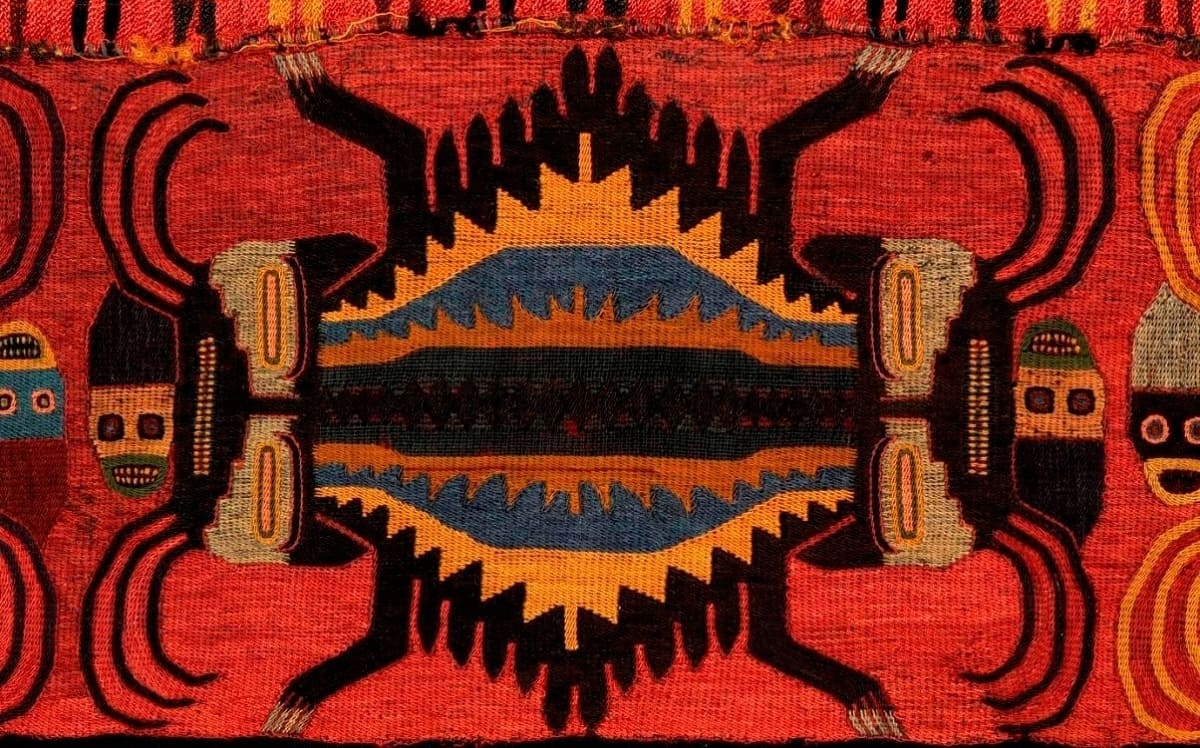The Paracas Culture was an important society in the history of Peru, well known for its textile art, its mummies and for cranial trephination to cure fractures and tumors in the skull.
They arose roughly between 700 B.C. and 200 AD, with extensive knowledge of irrigation and water management. Most of our information about the lives of the inhabitants of the Paracas culture comes from excavations at the Paracas necropolis, first investigated by the Peruvian archaeologist Julio C. Tello in the 1920s. The Wari Kayan necropolis consisted in a multitude of large underground burial chambers, with an average capacity of about forty mummies. It is suggested that each large chamber might have been owned by a specific family or clan, which they used for many generations. Each mummy was tied with wire to hold it in place, and then wrapped in many layers of intricate textiles, ornamentals, and fine fabric. These textiles are now known as some of the finest ever produced by Andean pre-Columbian societies, and are the main works of art for which the Paracas culture is known.
Geographical Location of the Paracas Culture
It was developed on the Paracas peninsula, located in what is now the Paracas district of the Pisco province, in the Ica Region, located 18 km from the city of Pisco. Its main centers were in the Paracas Bay and its influence reached Chincha, Pisco, Ica, Palpa and Río Grande. The Paracas culture extended to the north to the Cañete valley and to the south to the Llauca valley in Arequipa, as important remains of this culture in the Ica valley are two villages Peña Vajahuana and Animas Altas and in the valley of Chincha the Huaca Rosa.
Social and Political Organization
The Paracas Culture was highly influenced by the Chavín culture, this influence was reflected above all in their religious life and in the theocratic government that were in the hands of the priests who implanted an oppressive system, likewise there is the existence of a chain of centers ceremonies in charge of these priests.
The social organization was divided by priests, warrior nobility and the people.
In the Paracas culture there was a group of military priests who, due to their knowledge of the stars and control of irrigation water, maintained religious, political and technological control.
The population of the Paracas culture was made up mostly of peasants who accepted everything the priests said because they feared the punishments of the gods if they did not obey. The inhabitants accepted that the priests governed in the name of the Gods.

Periods of the Paracas Culture
In the Paracas culture, according to the eminent archaeologist Julio C. Tello, two successive cultures or phases are distinguished, taking into account the way they buried their dead: Paracas-caverns and Paracas-necropolis.
Paracas Caverns
The tombs of this culture were found on Cerro Colorado, a place located 18 kilometers south of Pisco. The caverns are located under the sand, two meters deep; they have the shape of an inverted cup. There they found mummies wrapped with bundles, made with cloth that were surrounded by food offerings: corn, cassava, beans, lima beans, etc. The population must have been farmers, warriors, religious and happy.
They built the fortified town of Tajahuana, on a stony plateau that rises 200 meters above the level of the crops. In the same way, they built their houses on the slopes of the hills.
At first they worshiped an ocular being, a character without a body, with only eyes and a mouth. Later, this being took the form of a fearsome character who carried a knife and a head-trophy in her hands.
Finally, the cheerful character of the population is manifested by the presence of musical instruments, such as drums, trumpets, antaras and whistles.

Paracas Necropolis
This cultural phase is symbolized by a large rectangular cemetery. There the settlers buried the members of the dominant caste. For this purpose, they were returned in finely embroidered cloth, together with food and gold ornaments and ceramic pieces. The walls of their tombs are built of small stones joined with calcareous mud, which when hardened is like cement; the roofs, of huarango sticks or whale bones.
To bury the corpses, they previously mummified them according to the following procedure:
- Its intestines and viscera were extracted from the corpse by opening it longitudinally.
- They then extracted the heart by cutting the thorax.
- They cut the head at the base of the skull to empty the brain mass, although there are mummies with dried brain mass.
- Cotton plugs were placed in the eye sockets.
- They removed the muscles through incisions in the upper and lower extremities.
- Finally, it was mummified by introducing lime, ground chili pepper, ground salt, powdered muña flower, pitch and other ingredients into the corpse.
- They squatted the mummy.
- They subjected the corpse to a slow fire in order to reduce its size.
- Finally, it was placed in a reed basket to finally wrap it with fabrics of different quality.
Characteristics of the Paracas culture
The main characteristics of the Paracas culture are the following:
It was a hierarchical society, with a powerful ruling and priestly elite that controlled the labor force and commercial exchanges. The warrior class was also important.
They carried out hydraulic works, such as irrigation channels, so that they used the water from the rivers for agricultural activity.
Much of their resources came from the sea: they fished on the rich coastline, where they collected shellfish and hunted sea lions along with other animal species.
From the discovery of the burials of objects that were not produced in the region, it is known that they carried out commercial exchanges with peoples of the jungle, the mountains and the Andean coast.
They performed complex funeral rituals. They carried out procedures to mummify the dead. Then, they deposited them in baskets and covered them with different offerings that were wrapped in successive textile pieces, some of which reach 20 meters in length. These wrappers are known as funeral bundles.
They practiced cranial deformations on children. Some remains also show evidence of surgical interventions.
Religion of the Paracas Culture
According to the images present in the textiles, scholars consider that the Paracas society had totemic beliefs. That is, they considered certain animals as the divine ancestors of the group.
They had a tripartite conception of the universe made up of three instances: earth, air and water, and inhabited by fantastic beings that belonged to each of these worlds (serpent and feline, condor and orca).
In the textiles, hybrid characters also appear, human-shaped figures and attributes that associate them with animals and suggest rituals carried out by shaman priests.
Paracas Architecture
The characteristic architecture of the Paracas culture was manifested in monumental buildings of which few remains remain. These were made with conical-shaped adobe bricks, called adobitos, which were made by hand.
In the Chincha valley, several archaeological sites were found that preserve the remains of adobe buildings with sunken patios. These sites are linked by roads and geoglyphs and aligned with the sun. Said construction of a ritual landscape would be the evidence of a society controlled by an elite with religious rather than political power.
Economic Activities
Paracas is one of the most desert areas of the Peruvian coast, it is very hot, there is no rain and the rivers are very irregular, but the inhabitants of the Paracas culture dominated the desert and turned the arid areas into green valleys. The inhabitants of the Paracas culture had great knowledge of irrigation, they controlled the scarcity and excess of water, taking advantage of the underground and surface water, they led the cause that descended disorderly by rivers, taking them through irrigation channels that started from intakes located kilometers above, they also used the technique of the sunken farm or Wachaque that consists of removing the superficial layer of the arid earth and leaving the layer with the humidity of the subsoil exposed, this technique allowed them to sow and grow food.
Another great achievement of the Paracas culture was the use of the excrement of the guano birds to fertilize the land, their main crops were cotton, pallar and corn. Cotton was a very important crop for the elaboration of their fabrics, they knew white and colored cotton, lima beans and corn were basic in their diet.
Due to their location near the coast, the Paracas also took advantage of the riches of the sea, including fish and shellfish in their diet. They developed navigation techniques which facilitated communication with other coastal towns such as Chincha for example, they also traveled to towns in the mountains to exchange cotton, salt and marine products with the towns of the mountains where the people of the Paracas culture obtained wool and dyes that they needed to manufacture their textiles and ceramics, from the jungle they obtained coca leaves and feathers for their cloaks.
Cultural Manifestations
Textile Art
They were the most notable in textile art with high quality materials such as: alpaca, vicuña wool, cotton, multicolored feathers, etc. They used geometric drawings and a beautiful combination of colors: red, blue, yellow, black, white, etc.
It is considered the best of all ancient cultures since it was very harmonious and with many colors, they had animal, anthropomorphic and geometric designs, some feathers included.
The Mantles of the Paracas culture are known throughout the world for their high quality and fine fabrics.

Medicine and Surgery
They were experts in surgical operations, especially in the trephination of skulls in order to cure fractures, infections and tumors. They used the coca leaf as an anesthetic, chicha de jora (alcoholic drink made from yellow corn) to counteract pain and prevent infections.
Ceramics
Their pottery was sculptural and spherical like the shape of a gourd with two spouts and a bridge. Their motifs were felines, fish, birds, snakes (influence of the Chavín Culture). At the time of Paracas Cavernas (Paracas Cave) and later polychromy was used, however in the Paracas Necropolis (Paracas Necropolis), pre-combustion cream colors and monochrome styles were used.
Best Trekking and Tours in Peru
Many are the routes that take you to Machu Picchu, but none is like the Inca Trail Tours, the most famous pedestrian path in the Americas. After flying from the capital of Peru, Lima, you will arrive in Cusco to walk for four days along a path through forests and dense fog, millenary stone steps and discovering the ruins of ancient fortifications and Inca cities, and all the time enjoying majestic views.
- Sacred Valley Bike Tour
- Honeymoon in Machu Picchu
- 1 Day Inca Trail Hike to Machu Picchu
- Sacred Valley Tours
- Lares Trek to Machu Picchu 4 Days
- Huchuy Qosqo Trek to Machu Picchu
- Short 2 Day Inca Trail Hike to Machu Picchu
- 2 Day Inca Trail with Camping
- Apu Ausangate Trek 7 days
- 4 Day Jungle Trek to Machu Picchu
- Inca Quarry Trail to Machu Picchu
- Urubamba River Rafting
- 5 Days Salkantay Mountain Trek
- 3 Days Salkantay Trek to Machu Picchu
- Huchuy Qosqo Trek to Machu Picchu
- 7 Lakes Ausangate Trek
If you want to visit Machu Picchu, we recommend you to book your Machu Picchu Ticket in advance, so you will enjoy your Vacation in Machu Picchu without any problem.






